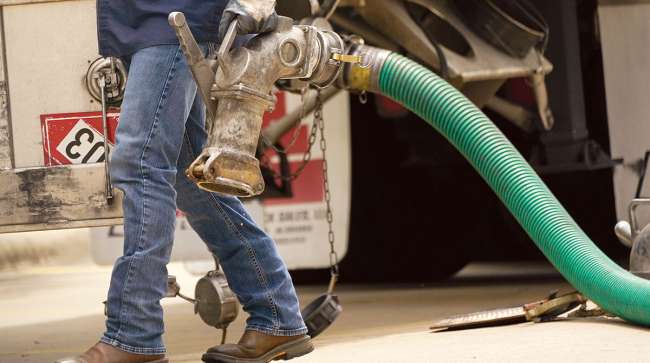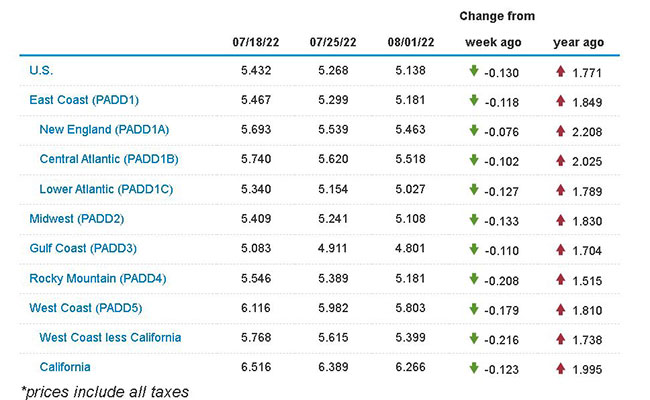Average Price of Diesel Sheds Another 13¢ to Reach $5.138 a Gallon

[Stay on top of transportation news: Get TTNews in your inbox.]
The national average price for a gallon of diesel continued to decrease, falling 13 cents to $5.138, according to Energy Information Administration data released Aug. 1.
Diesel’s price has fallen for six consecutive weeks, including declines of at least a dime in the past five. It’s a stark comparison with March 7, which showed a 74.5-cent increase from the week of Feb. 28.
The cost of a gallon of diesel has come down 67.2 cents since peaking at $5.81 on June 20. Trucking’s main fuel declined in all 10 regions in EIA’s weekly survey, with declines ranging from a high of 21.6 cents a gallon in the West Coast less California to a low of 7.6 cents in New England. A gallon costs less than $5 in one region ($4.801 in Gulf Coast) and more than $6 in one ($6.266 in California). Despite the decreases, diesel still costs $1.771 more than it did at this time in 2021.
U.S. On-Highway Diesel Fuel Prices

EIA.gov
Gasoline’s national average is now down to $4.192 a gallon after falling 13.8 cents.
Industry experts say two main factors are pushing down the price of gas and diesel, moderating demand for transportation fuels and slumping prices for oil. Oil prices extended their declines Aug, 1, hitting a nearly four-month low with signs of slowing international manufacturing activity. West Texas Intermediate futures dipped 0.2% to close at $93.66 a barrel, the lowest level since early April.

Flynn
Industry analyst Phil Flynn told Transport Topics that as vacation season wraps up in the next month he anticipates demand to wane. However, he cautions that August and September are potentially busy months in terms of hurricane activity in the Gulf of Mexico. According to the Energy Information Administration, offshore oil production there accounts for 17% of the country’s crude oil production and 5% of its federal offshore dry gas production.
14 TO 20 NAMED STORMS EXPECTED: NOAA updates forecast
More importantly Flynn said, over 47% of total U.S. petroleum refining capacity is located along the Gulf Coast, as well as 51% of total U.S. natural gas processing plant capacity.
“We’ve gotten a false sense of security these past several weeks,” Flynn said. “I think we are getting a post-summer decline here. So enjoy the summer vacation with the lower prices for diesel and gasoline, but I think we could be facing reality here in a couple of weeks.”
U.S. average on-highway #diesel fuel price on August 1, 2022 was $5.138/gal, DOWN 13.0¢/gallon from 7/25/22, UP $1.771/gallon from year ago #truckers #shippers #fuelprices https://t.co/bz9DGdgdaD pic.twitter.com/3Ht28eM44k — EIA (@EIAgov) August 2, 2022
Flynn said he is concerned that, according to the Department of Energy, the Strategic Petroleum Reserve is at its lowest level since May 1985. The SPR, which holds oil in underground tanks in Louisiana and Texas, was down to 469.9 million barrels, a decline from 618 million barrels last September. The SPR is the largest known emergency supply of oil in the world and has a capacity for 714 million barrels. Earlier this year, in an effort to combat rising fuel prices, President Joe Biden ordered the release of 1 million barrels of oil per day to increase supplies.

De Haan
Patrick De Haan, the head of petroleum analysis at GasBuddy.com, told TT he sees prices continue to slowly decline so long as the Gulf of Mexico remains calm.
“Prices are falling for once; we have seen prices down close to 90 cents a gallon since June. Diesel prices are lagging a bit because inventories are tight, but it’s nice to see motorists getting a break. We’ll take what we can,” he said. “Hurricane activity is a concern. If we see a Hurricane Harvey or an Irma, there is a little bit of anxiety over what Mother Nature could throw at us.”
Hurricane Harvey was a Category 4 hurricane that made landfall on Texas and Louisiana in August 2017, causing catastrophic flooding and more than 100 deaths. Energy production in the Gulf declined in the wake of Harvey by approximately 21% to 378,600 barrels per day from the original 1.75 million.
As a result of Harvey, 25% of U.S. refining capacity had to be taken off-line. Refining runs on the U.S. Gulf Coast hit a record low in the week of Sept. 1 due to shutdowns.
Hurricane Irma followed a month later and while it missed a direct hit on the region, it still caused the evacuation of some oil platforms and other facilities.
Want more news? Listen to today's daily briefing below or go here for more info:


